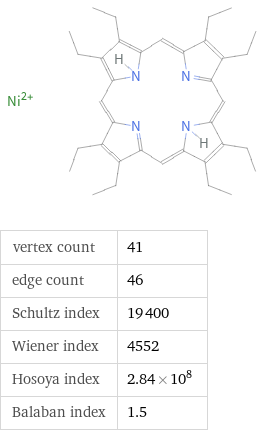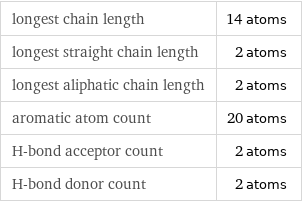Input interpretation

2, 3, 7, 8, 12, 13, 17, 18-octaethyl-21 h, 23 h-porphine nickel(ii)
Basic properties
![molar mass | 593.5 g/mol formula | (C_36H_46N_4Ni)^2+ empirical formula | Ni_C_36N_4H_46 SMILES identifier | CCC1=C(CC)C2=CC3=NC(=CC4=C(CC)C(=C(C=C5C(=C(CC)C(=N5)C=C1N2)CC)N4)CC)C(=C3CC)CC.[Ni+2] InChI identifier | InChI=1/C36H46N4.Ni/c1-9-21-22(10-2)30-18-32-25(13-5)26(14-6)34(39-32)20-36-28(16-8)27(15-7)35(40-36)19-33-24(12-4)23(11-3)31(38-33)17-29(21)37-30;/h17-20, 37, 40H, 9-16H2, 1-8H3;/q;+2 InChI key | XZBPEZWMHLCUAM-UHFFFAOYSA-N](../image_source/8be67009f5098d0484ca0d95b384a125.png)
molar mass | 593.5 g/mol formula | (C_36H_46N_4Ni)^2+ empirical formula | Ni_C_36N_4H_46 SMILES identifier | CCC1=C(CC)C2=CC3=NC(=CC4=C(CC)C(=C(C=C5C(=C(CC)C(=N5)C=C1N2)CC)N4)CC)C(=C3CC)CC.[Ni+2] InChI identifier | InChI=1/C36H46N4.Ni/c1-9-21-22(10-2)30-18-32-25(13-5)26(14-6)34(39-32)20-36-28(16-8)27(15-7)35(40-36)19-33-24(12-4)23(11-3)31(38-33)17-29(21)37-30;/h17-20, 37, 40H, 9-16H2, 1-8H3;/q;+2 InChI key | XZBPEZWMHLCUAM-UHFFFAOYSA-N
Structure diagram

vertex count | 41 edge count | 46 Schultz index | 19400 Wiener index | 4552 Hosoya index | 2.84×10^8 Balaban index | 1.5
Quantitative molecular descriptors

longest chain length | 14 atoms longest straight chain length | 2 atoms longest aliphatic chain length | 2 atoms aromatic atom count | 20 atoms H-bond acceptor count | 2 atoms H-bond donor count | 2 atoms
Elemental composition

Find the elemental composition for 2, 3, 7, 8, 12, 13, 17, 18-octaethyl-21 h, 23 h-porphine nickel(ii) in terms of the atom and mass percents: atom percent = N_i/N_atoms × 100% mass percent = (N_im_i)/m × 100% Plan: • Write the chemical formula and gather atomic masses from the periodic table. • Determine values for N_i, m_i, N_atoms and m using these items. • Finally, compute the percents and check the results. Write the chemical formula: (C_36H_46N_4Ni)^2+ Use the chemical formula to count the number of atoms, N_i, for each element and find the total number of atoms, N_atoms, per molecule: | number of atoms Ni (nickel) | 1 C (carbon) | 36 N (nitrogen) | 4 H (hydrogen) | 46 N_atoms = 1 + 36 + 4 + 46 = 87 Divide each N_i by N_atoms to calculate atom fractions. Then use the property that atom fractions must sum to one to check the work: | number of atoms | atom fraction Ni (nickel) | 1 | 1/87 C (carbon) | 36 | 36/87 N (nitrogen) | 4 | 4/87 H (hydrogen) | 46 | 46/87 Check: 1/87 + 36/87 + 4/87 + 46/87 = 1 Compute atom percents using the atom fractions: | number of atoms | atom percent Ni (nickel) | 1 | 1/87 × 100% = 1.15% C (carbon) | 36 | 36/87 × 100% = 41.4% N (nitrogen) | 4 | 4/87 × 100% = 4.60% H (hydrogen) | 46 | 46/87 × 100% = 52.9% Look up the atomic mass, m_i, in unified atomic mass units, u, for each element in the periodic table: | number of atoms | atom percent | atomic mass/u Ni (nickel) | 1 | 1.15% | 58.6934 C (carbon) | 36 | 41.4% | 12.011 N (nitrogen) | 4 | 4.60% | 14.007 H (hydrogen) | 46 | 52.9% | 1.008 Multiply N_i by m_i to compute the mass for each element. Then sum those values to compute the molecular mass, m: | number of atoms | atom percent | atomic mass/u | mass/u Ni (nickel) | 1 | 1.15% | 58.6934 | 1 × 58.6934 = 58.6934 C (carbon) | 36 | 41.4% | 12.011 | 36 × 12.011 = 432.396 N (nitrogen) | 4 | 4.60% | 14.007 | 4 × 14.007 = 56.028 H (hydrogen) | 46 | 52.9% | 1.008 | 46 × 1.008 = 46.368 m = 58.6934 u + 432.396 u + 56.028 u + 46.368 u = 593.4854 u Divide the mass for each element by m to calculate mass fractions. Then use the property that mass fractions must sum to one to check the work: | number of atoms | atom percent | mass fraction Ni (nickel) | 1 | 1.15% | 58.6934/593.4854 C (carbon) | 36 | 41.4% | 432.396/593.4854 N (nitrogen) | 4 | 4.60% | 56.028/593.4854 H (hydrogen) | 46 | 52.9% | 46.368/593.4854 Check: 58.6934/593.4854 + 432.396/593.4854 + 56.028/593.4854 + 46.368/593.4854 = 1 Compute mass percents using the mass fractions: Answer: | | | number of atoms | atom percent | mass percent Ni (nickel) | 1 | 1.15% | 58.6934/593.4854 × 100% = 9.890% C (carbon) | 36 | 41.4% | 432.396/593.4854 × 100% = 72.86% N (nitrogen) | 4 | 4.60% | 56.028/593.4854 × 100% = 9.441% H (hydrogen) | 46 | 52.9% | 46.368/593.4854 × 100% = 7.813%
Elemental oxidation states

The first step in finding the oxidation states (or oxidation numbers) in 2, 3, 7, 8, 12, 13, 17, 18-octaethyl-21 h, 23 h-porphine nickel(ii) is to draw the structure diagram. Next set every oxidation number equal to the atom's formal charge: In 2, 3, 7, 8, 12, 13, 17, 18-octaethyl-21 h, 23 h-porphine nickel(ii) hydrogen is not bonded to a metal with lower electronegativity, so it will have an oxidation state of +1. Any element bonded to hydrogen gains the bonding electrons, decreasing their oxidation state by 1 for every bond: With hydrogen out of the way, look at the remaining bonds. There are 8 carbon-nitrogen bonds, and 36 carbon-carbon bonds. For each of these bonds, assign the bonding electrons to the most electronegative element. First examine the carbon-nitrogen bonds: element | electronegativity (Pauling scale) | C | 2.55 | N | 3.04 | | | Since nitrogen is more electronegative than carbon, the electrons in these bonds will go to nitrogen. Decrease the oxidation number for nitrogen in every highlighted bond (by 1 for single bonds, 2 for double bonds, and 3 for triple bonds), and increase the oxidation number for carbon accordingly: Next look at the carbon-carbon bonds: element | electronegativity (Pauling scale) | C | 2.55 | C | 2.55 | | | Since these elements are the same the bonding electrons are shared equally, and there is no change to the oxidation states: Now summarize the results: Answer: | | oxidation state | element | count -3 | C (carbon) | 8 | N (nitrogen) | 4 -2 | C (carbon) | 8 -1 | C (carbon) | 4 0 | C (carbon) | 8 +1 | C (carbon) | 6 | H (hydrogen) | 46 +2 | C (carbon) | 2 | Ni (nickel) | 1